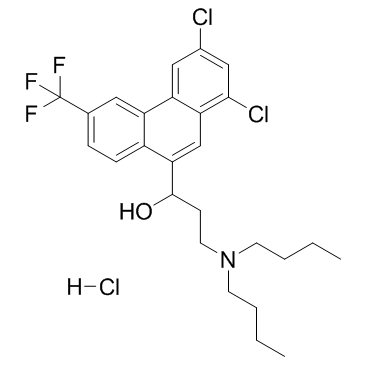Effects of anti-malarial drugs on the electrocardiographic QT interval modelled in the isolated perfused guinea pig heart system.
Atsushi Kinoshita, Harumi Yamada, Hajime Kotaki, Mikio Kimura
文献索引:Malaria Journal 9 , 318, (2010)
全文:HTML全文
摘要
Concern over the potential cardiotoxicity of anti-malarial drugs inducing a prolonged electrocardiographic QT interval has resulted in the almost complete withdrawal from the market of one anti-malarial drug - halofantrine. The effects on the QT interval of four anti-malarial drugs were examined, using the guinea pig heart.The guinea pig heart was isolated, mounted on a Langendorff apparatus, and was then perfused with pyruvate-added Klebs-Henseleit solutions containing graded concentrations of the four agents such as quinidine (0.15 - 1.2 μM), quinine (0.3 - 2.4 μM), halofantrine (0.1 - 2.0 μM) and mefloquine (0.1 - 2.0 μM). The heart rate-corrected QaTc intervals were measured to evaluate drug-induced QT prolongation effects.Quinidine, quinine, and halofantrine prolonged the QaTc interval in a dose-dependent manner, whereas no such effect was found with mefloquine. The EC50 values for the QaTc prolongation effects, the concentration that gives a half-maximum effect, were quinidine < quinine ≈ halofantrine.In this study, an isolated, perfused guinea pig heart system was constructed to assess the cardiotoxic potential of anti-malarial drugs. This isolated perfused guinea pig heart system could be used to test newly developed anti-malarial drugs for their inherent QT lengthening potential. More information is required on the potential variation in unbound drug concentrations in humans, and their role in cardiotoxicity.
相关化合物
| 结构式 | 名称/CAS号 | 分子式 | 全部文献 |
|---|---|---|---|
 |
盐酸卤泛群
CAS:36167-63-2 |
C26H31Cl3F3NO |
|
Effect of serum lipoproteins on stereoselective halofantrine...
2012-07-01 [Chirality 24(7) , 558-65, (2012)] |
|
Discordant temporal evolution of Pfcrt and Pfmdr1 genotypes ...
2012-03-01 [Antimicrob. Agents Chemother. 56(3) , 1382-9, (2012)] |
|
Using resin to generate a non-invasive intestinal bile-deple...
2012-09-29 [Eur. J. Pharm. Sci. 47(2) , 347-51, (2012)] |
|
Population pharmacokinetics of halofantrine in healthy volun...
2012-11-01 [J. Pharm. Pharmacol. 64(11) , 1603-13, (2012)] |
|
CDA: combinatorial drug discovery using transcriptional resp...
2012-01-01 [PLoS ONE 7(8) , e42573, (2012)] |